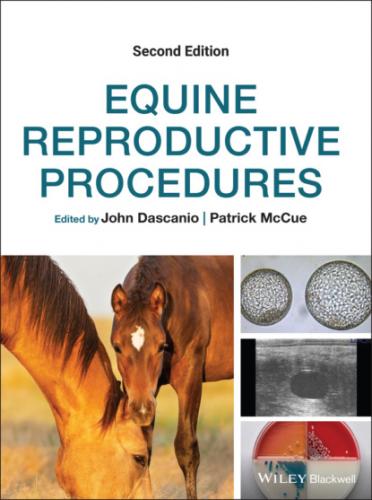With a new sterile swab, streak through the primary streak one or more times and continue to streak the second third of the plate (secondary streak).
With a new sterile swab, streak through the secondary streak one or more times and continue to streak the final third of the plate (tertiary streak). The concept is to separate the colonies so that individual colonies can be identified.
Perform the same streaking pattern on the other quadrants.Figure 14.2 Culture of Streptococcus equi subspecies zooepidemicus on a quad plate with TSA with 5% sheep blood (upper right), MacConkey II agar (upper left), Gram‐positive chromogenic agar (lower right), and Gram‐negative chromogenic agar (lower left). Note the growth of small white colonies with β‐hemolysis (black arrow) on blood agar, the lack of growth on MacConkey agar, and the small light blue colonies on the Gram‐positive chromogenic agar.
If additional agars are to be used, inoculate in the same manner as previously described.
Incubate the plate(s), bottom side up in a 37°C (99°F) incubator for 20–24 hours.
After incubation, observe the quad plate for the appearance of any colony growth and determine if more than one type of colony is present. Identify hemolytic activity of colonies developing on TSA agar. Determine if contaminants are present (e.g., where are the colonies located on the plate, are they actually touching a streak line, are there more than one type of colony?) (Figures ; Table 14.2).
Observe any additional inoculated agars for presumptive identification or growth of a fungal/yeast organism (i.e., Sabouraud agar).
Characterize the amount of growth as either no growth, very light growth, light growth, moderate growth, or heavy growth.
Plates with mixed growth should be subcultured and individual organisms subsequently identified.
Plates should be cultured for a minimum of 72 hours before being discarded.
Figure 14.3 Culture of Escherichia coli on a quad plate with TSA with 5% sheep blood (upper right), MacConkey II agar (upper left), Gram‐positive chromogenic agar (lower right), and Gram‐negative chromogenic agar (lower left). Note the growth of cream‐colored colonies without hemolysis on blood agar, the medium‐sized pink colonies on MacConkey agar, and the pink to red colonies on Gram‐negative chromogenic agar.
Figure 14.4 Culture of Pseudomonas aeruginosa on a quad plate with TSA with 5% sheep blood (upper right), MacConkey II agar (upper left), Gram‐positive chromogenic agar (lower right), and Gram‐negative chromogenic agar (lower left). Note the growth of flat metallic green‐blue colonies on blood agar, the large pale greenish colonies on MacConkey agar, and the growth of transparent white to green colonies on Gram‐negative chromogenic agar.
Figure 14.5 Culture of Klebsiella pneumoniae on a quad plate with TSA with 5% sheep blood (upper right), MacConkey II agar (upper left), Gram‐positive chromogenic agar (lower right), and Gram‐negative chromogenic agar (lower left). Note the growth of large gray mucoid colonies without hemolysis on blood agar, the large pink mucoid colonies on MacConkey agar, and the growth of large blue colonies with a slight pink halo on Gram‐negative chromogenic agar.
Table 14.2 Culture characteristics for common microbial organisms associated with infectious equine endometritis.
| Organism | Gram Stain | Morphology | TSA/5% Sheep Blood Agar | MacConkey Agar | Chromogenic Agar | Comments |
|---|---|---|---|---|---|---|
| Streptococcus equi subsp. zooepidemicus | Pos. | Cocci (ovoid, chains) | Small, white, round colonies (β‐hemolysis) (0.5–1.0 mm) | No growth | Small, light blue colonies | |
| Escherichia coli | Neg. | Rods | Cream‐colored colonies (α‐hemolysis) (2–3 mm) | Medium sized, gray to pink colonies | Medium, pink to red colonies | |
| Klebsiella pneumoniae | Neg. | Rods | Large, gray, mucoid colonies (non‐hemolytic) (2–4 mm) | Large, pink, mucoid colonies | Large, blue with slight pink halo colonies | |
| Pseudomonas aeruginosa | Neg. | Rods | Flat metallic blue colonies (β‐hemolysis) (3–4 mm) | Large, pale greenish colonies | Transparent white to green colonies | Grape‐like odor on blood agar; fluorescence with Wood’s UV light |
| Staphylococcus aureus | Pos. | Cocci (round, clusters) | Medium, cream to gold colonies (± β‐hemolysis) (2–3 mm) | No growth or limited growth of pink colonies | White to light yellow colonies | |
|
|
